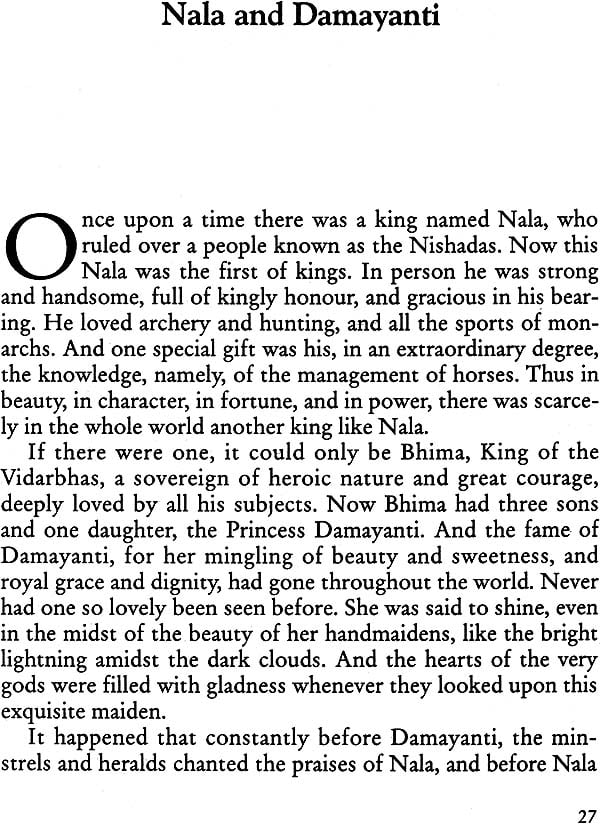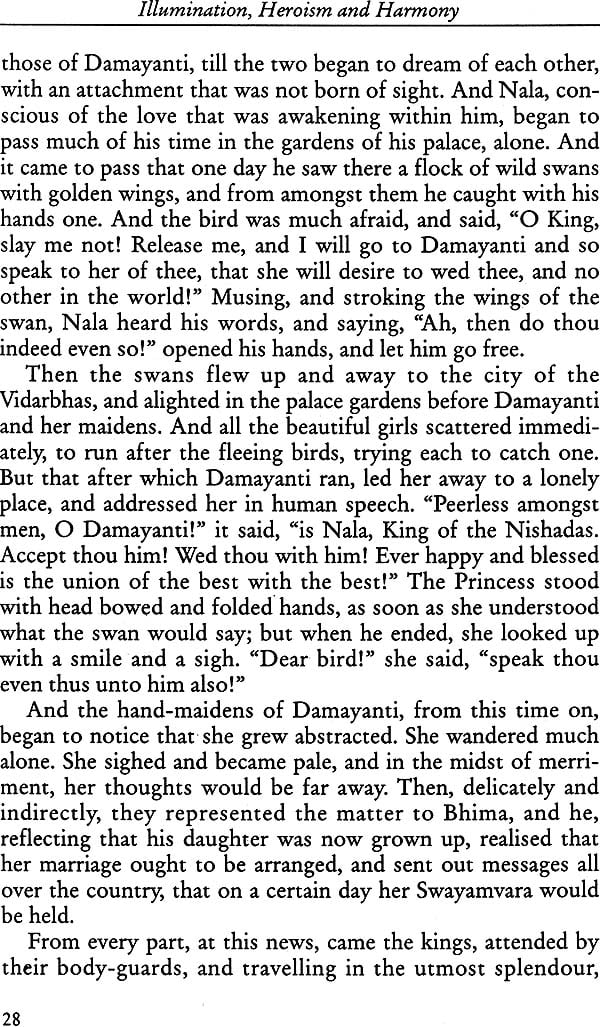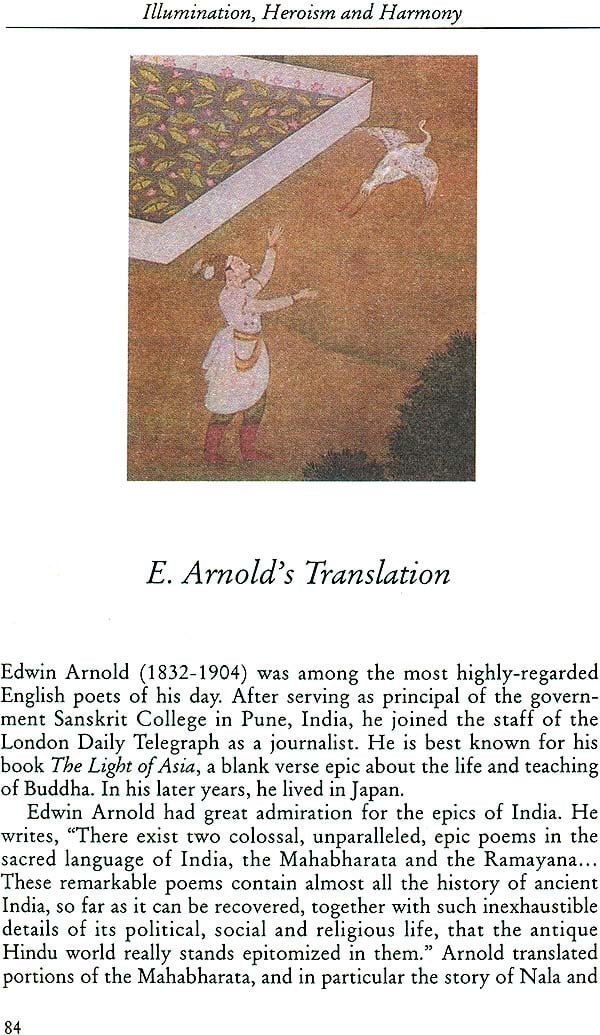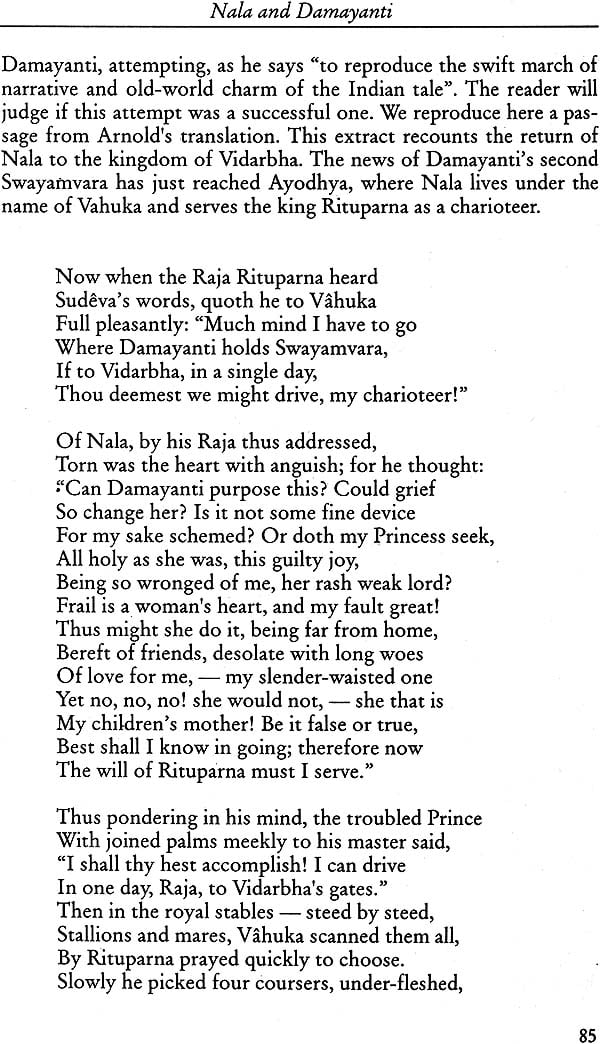
Nala and Damayanti
Book Specification
| Item Code: | IDH078 |
| Author: | Kireet Joshi |
| Publisher: | Indian Council of Philosophical Research (ICPR) |
| Language: | English |
| Edition: | 2004 |
| ISBN: | 8185636869 |
| Pages: | 92(Color Illus : 6, B & W Illus: 8) |
| Cover: | Paperback |
| Other Details | 8.9" X 5"8 |
| Weight | 200 gm |
Book Description
About the Book
Illumination, heroism and harmony are three major powers that can uplift to higher and higher levels. It may be useful to explore and illustrate the meanings of these three terms by giving examples of those qualities through appropriate stories. This monograph, entitled Nala and Damayanti, could as well have been called "the Art of Victory". This ancient story by wisdom enabled two human beings, crushed by adverse circumstances, to emerge victorious from a terrible ordeal. Because they were intensely pure and sincere, they could, even at the worst moments, remain open to luminous intuitions; they could keep their strength and courage; they could let themselves be guided at all times by an invisible hand. By constantly invoking a higher force, they placed themselves under ts protection and they kept their mind and heart open to its action-that force actively present in the universe that pushes towards justice, harmony and unity. This is an extraordinary demonstration of how, by clinging to the golden thread of love and faith, one can traverse the whirlpools and dangerous undercurrents of the river of life and reach the other shore, on the firm ground of joy and freedom. There is nothing surprising in the fact that this story, like all those to be found in the ancient epics of India, contains great knowledge. The poets who wrote them did not intend merely to tell a tale in a beautiful or the people. They were architects and sculptors of life. Their epics contain a deep reflection on life, on psychology, on society, politics and religion-a pure fountain of knowledge at which, even today, one can quench one's thirst..
The task of preparing teaching-learning material for value- oriented education is enormous.
I There is, first, the idea that value-oriented education should be exploratory rather than prescriptive, and that the teaching- learning material should provide to the learners a growing experience of exploration.
Secondly, it is rightly contended that the proper inspiration to turn to value-orientation is provided by biographies, auto- biographical accounts, personal anecdotes, epistles, short poems, stories of humour, stories of human interest, brief pas- sages filled with pregnant meanings, reflective short essays written in well-chiselled language, plays, powerful accounts of historical events, statements of personal experiences of values in actual situations of life, and similar other statements of scientific, philosophical, artistic and literary expression.
Thirdly, we may take into account the contemporary fact that the entire world is moving rapidly towards the synthesis of the East and the West, and in that context, it seems obvious that our teaching-learning material should foster the gradual familiarisation of students with global themes of universal significance as also those that underline the importance of diversity in unity. This implies that the material should bring the students nearer to their cultural heritage, but also to the highest that is available in the cultural experiences of the world at large.
Fourthly, an attempt should be made to select from Indian and world history such examples that could illustrate the theme of the upward progress of humankind. The selected research material could be multi-sided, and it should be presented in such a way that teachers can make use of it in the manner and in the context that they need in specific situations that might obtain or that can be created in respect of the students.
The research team at the Sri Aurobindo International Institute of Educational Research (SAIlER) has attempted the creation of the relevant teaching-learning material, and they have decided to present the same in the form of monographs. The total number of these monographs will be around eighty to eighty- five.
It appears that there are three major powers that uplift life to higher and higher normative levels, and the value of these powers, if well illustrated, could be effectively conveyed to the learners for their upliftment. These powers are those of illumination, heroism and harmony.
It may be .useful to explore the meanings of these terms - illumination, heroism and harmony - since the aim of these monographs is to provide material for a study of what is sought to be conveyed through these three terms. We offer here exploratory statements in regard to these three terms.
Illumination is that ignition of inner light in which meaning and value of substance and life-movement are seized, understood, comprehended, held, and possessed, stimulating and inspiring guided action and application and creativity culminating in joy, delight, even ecstasy. The width, depth and height of the light and vision determine the degrees of illumination, and when they reach the splendour and glory of synthesis and harmony, illumination ripens into wisdom. Wisdom, too, has varying degrees that can uncover powers of knowledge and action, which reveal unsuspected secrets and unimagined skills of art and craft of creativity and effectiveness.
Heroism is, essentially, inspired force and self-giving and sacrifice in the operations of will that is applied to the quest, realisation and triumph of meaning and value against the resistance of limitations and obstacles by means of courage, battle and adventure. There are degrees and heights of heroism determined by the intensity, persistence and vastness of sacrifice. Heroism attains the highest states of greatness and refinement when it is guided by the highest wisdom and inspired by the sense of service to the ends of justice and harmony, as well as when tasks are executed with consummate skill.
Harmony is a progressive state and action of synthesis and equilibrium generated by the creative force of joy and beauty and delight that combines and unites knowledge and peace and stability with will and action and growth and development. Without harmony, there is no perfection, even though there could be maximisation of one or more elements of our nature. When illumination and heroism join and engender relations of mutuality and unity, each is perfected by the other and creativity is endless.
This particular monograph is entitled Nala and Damayanti. This ancient story by the poet-Rishi Vyasa recounts how hero- ism guided by wisdom enabled two human beings, crushed by adverse circumstances, to emerge victorious from a terrible ordeal. Because they were intensely pure and sincere, they could, even at the worst moments, remain open to luminous intuitions; they could keep their strength and courage;. they could let themselves be guided at all times by an invisible hand. By constantly invoking a higher force, they placed themselves under its protection and they kept their mind and heart open to its action - that force actively present in the universe that pushes towards justice, harmony and unity. This is an extraordinary demonstration of how, by clinging to the golden thread of love and faith, one can traverse the whirlpools and dangerous undercurrents of the river of life and reach the other shore, on the firm ground of joy and freedom.
A Lesson on Life
The story of Nala and Damayanti, as told in the Mahabharata, seems to begin and end like a fairy tale. Yet what happens in between is anything but a fairy tale - if we give to this word the meaning of something remote from real life. On the contrary, this is a universal story containing some of the deepest truths about life.
The story is about two human beings having immense qualities, placed in ideal circumstances: the king Nala and the princess Damayanti. It starts with a very pure love between them which is put to the test by the gods themselves, and then their marriage followed by a life of harmony and happiness. Then suddenly the smooth path is interrupted. A crack appears in this beautiful picture and widens more and more. An evil being named Kali enters the king, clouds his judgement and leads him to all kinds of disasters, including the loss of his kingdom, exile, the separation from his children, the abandoning of his wife in the forest, loneliness, suffering and servitude for both of them. Evil, doubt, pain, separation have appeared in the story of Nala and Damayanti, indeed as they often appear in our own life. For how many lives on this earth are not chequered lives? One rises, one falls; one gains, one loses. Rama is all set to be crowned King of Ayodbya and at that very moment he is sent into exile. Shakuntala awaits her marriage and then she is cursed by a Rishi and forgotten by her lover. Vishvamitra is about to reap the fruit of thousands of years of tapasya when he gets angry and loses everything in a second. Rare are the linear lives in which upheaval of some kind does not take place.
What does one need for going undefeated through all this? What makes some people sink and other people emerge stronger? And if it is true that the life of a man is a "search after pure Truth and unmixed Bliss", what are the helps in this search? And if it is true that human life is susceptible to deviation, how can those deviating forces be conquered? Since it contains many secrets about these questions, the story of Nala and Damayanti is considered an invaluable lesson in human life.
There is nothing surprising in the fact that this story, like all those to be found in the ancient epics of India, contains great knowledge. The poets who wrote them did not intend merely to tell a tale in a beautiful or noble manner or to create an interesting poem, although they did this with great success. The Mahabharata and the Ramayana are itihasa, that is to say, they are "an ancient historical or legendary tradition turned to creative use as a significant my thus or tale expressive of some spiritual or religious or ethical or ideal meaning and thus formative of the mind of the people." Valmiki and Vyasa indeed shaped the minds of the Indian people. They were architects and sculptors of life. Their epics contain a deep reflection on life, on human psychology, on society, politics and religion. If the Mahabharata has been spoken of as a fifth Veda, it is because it is not only a great poem, it is also a body of knowledge.
The work of these epics was to popularize through stories the discoveries of the great minds and souls of India: "That which was for the cultured classes contained in Veda and Upanishad, shut into profound philosophical aphorism and treatise or inculcated in Dharmashastra and Arthashastra, was put here into creative and living figures, associated with familiar story and legend, fused into a vivid representation of life and thus made a near and living power that all could readily assimilate through the poetic word appealing at once to the soul and the imagination and the intelligence. "
The Vedic Rishis had spoken of life as a battle between the forces of light and the forces of darkness. They had said that there are forces that help you in this battle, and there are forces that obstruct you. They had said that life is a sacrifice, and that as you burn your imperfections in the fire of sacrifice, you move upwards, you progress from untruth to truth. They had spoken of Rita, the right law of action originating in the vast consciousness of truth, and from that concept had come the idea of dharma . Those Vedic notions are present in the Mahabharata, brought out from an inner plane to an outer plane (ideas, ethics, politics), although in the tale of Nala and Damayanti (which is probably a very old story), they still keep their ancient and inner significance.




Click Here for More Books Published By Indian Council of Philosophical Research





